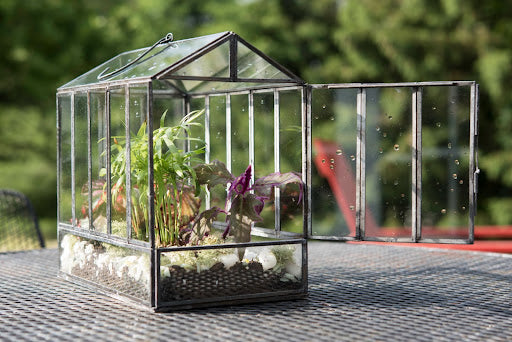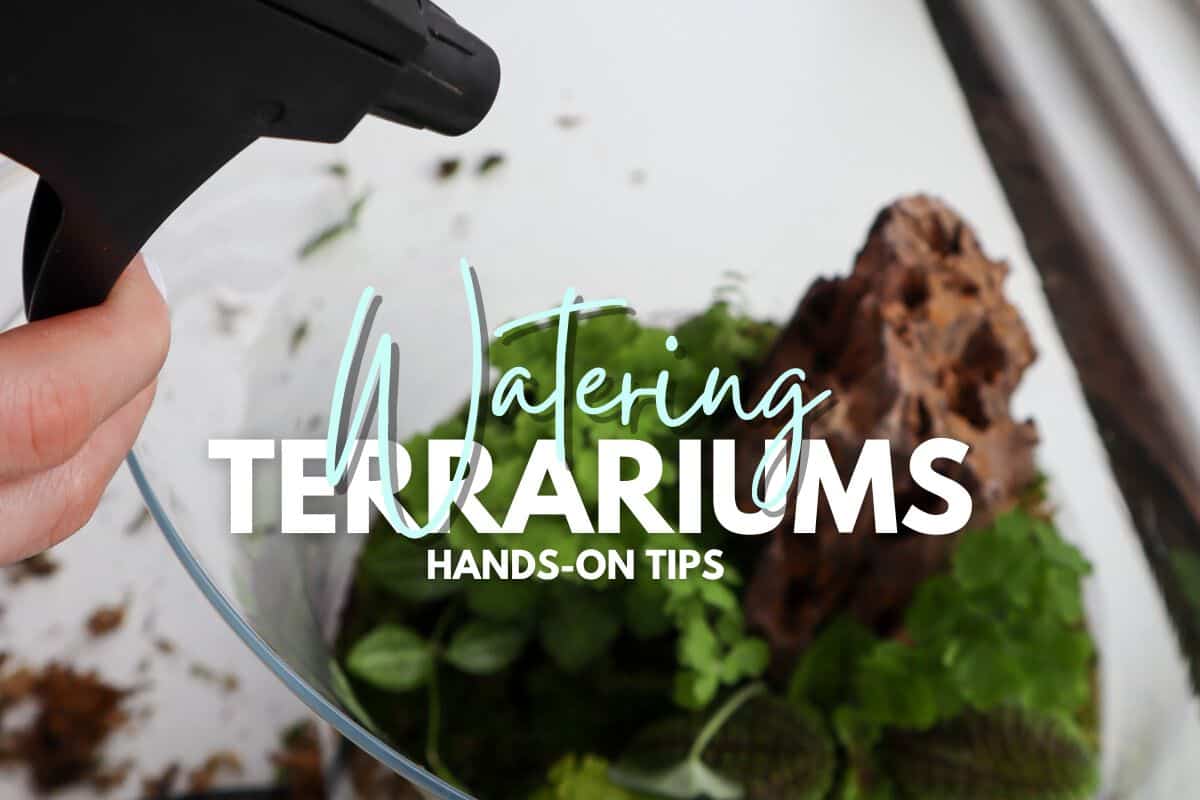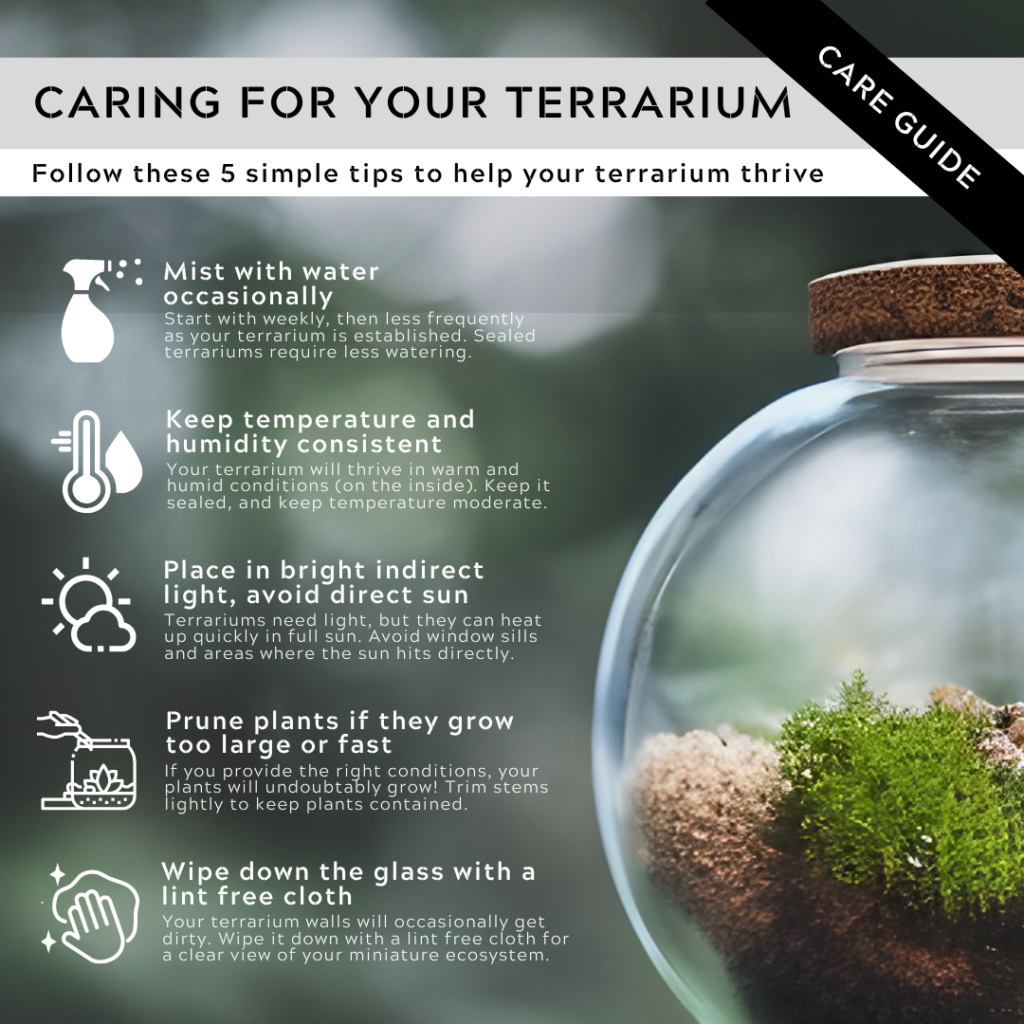Terrarium watering guidelines depend on the type of plants and terrarium setup. Generally, water when the soil feels dry to touch.
Terrariums are self-contained ecosystems that require careful water management to thrive. Overwatering can lead to mold growth and root rot, while underwatering can cause plants to wilt. Understanding the needs of the specific plants in your terrarium is crucial. Tropical plants often need more frequent watering compared to succulents, which prefer drier conditions.
Always use a spray bottle to water gently and evenly. Monitor the terrarium’s humidity levels and adjust watering frequency accordingly. Proper drainage is essential, so ensure your terrarium has layers like pebbles, charcoal, and soil to prevent waterlogging. Regularly check soil moisture to keep plants healthy.

Credit: urban-born.com
Choosing The Right Water
Watering your terrarium requires careful consideration. Choosing the right water type ensures your plants thrive. This guide will help you select the best water for your terrarium.
Tap Water Vs. Distilled Water
Tap water is easy to access. It contains minerals that may harm your plants. Chlorine and fluoride in tap water can damage delicate plants.
Distilled water is pure. It lacks harmful minerals and chemicals. Using distilled water keeps your terrarium healthy. It prevents mineral buildup.
| Water Type | Pros | Cons |
|---|---|---|
| Tap Water |
|
|
| Distilled Water |
|
|
Water Temperature
The temperature of the water is crucial. Cold water can shock your plants. Warm water helps nutrients absorb better.
Use water at room temperature. Room temperature water prevents plant stress. It promotes healthy growth.
Test the water before using it. Ensure it feels neither hot nor cold. This simple step keeps your terrarium plants happy.
Watering Frequency
Watering your terrarium correctly is very important. It helps plants grow well. The right frequency depends on your terrarium type. Let’s explore daily and weekly watering needs.
Daily Watering
Daily watering is rarely needed for terrariums. Only some types need daily care. For example, open terrariums with cacti or succulents need it.
To check, feel the soil. It should be dry before you water. Overwatering can harm your plants.
Weekly Watering
Weekly watering is common for most terrariums. Closed terrariums, especially, need this. It helps keep the soil moist but not wet.
- Check soil moisture weekly.
- Water lightly if soil feels dry.
- Avoid overwatering to prevent mold.
Here is a simple table for quick reference:
| Terrarium Type | Watering Frequency |
|---|---|
| Open Terrarium | Weekly |
| Closed Terrarium | Weekly |
| Cacti/Succulents | Daily (if needed) |
Signs Of Overwatering
Overwatering is a common mistake in terrarium care. It can harm your plants. Recognizing the signs early can save your green oasis.
Yellow Leaves
Yellow leaves are a clear sign of overwatering. Waterlogged soil prevents oxygen from reaching the roots. This causes the leaves to turn yellow.
- Leaves may appear wilted.
- Yellowing starts at the base of the plant.
- New growth may be stunted.
Check the soil moisture regularly. Use a moisture meter if needed. Ensure drainage is adequate to prevent water buildup.
Root Rot
Root rot is another consequence of overwatering. It occurs when roots stay wet for too long. This creates a breeding ground for fungi and bacteria.
| Signs | Description |
|---|---|
| Soft, Mushy Roots | Roots lose their firmness and become mushy. |
| Unpleasant Odor | Rotting roots emit a foul smell. |
| Blackened Roots | Healthy roots turn black or dark brown. |
To prevent root rot, ensure your terrarium has good drainage. Avoid watering too frequently. Allow the soil to dry out between waterings.
Signs Of Underwatering
Underwatering your terrarium can harm your plants. Recognizing the signs of underwatering can save your mini garden.
Wilting Plants
Wilting is a clear sign of underwatering. Plants lose their firmness and droop.
Check the leaves. Dry, crispy leaves indicate dehydration. Soft, limp leaves also show a lack of water.
If the leaves fall off easily, your plant is thirsty.
Dry Soil
Dry soil means your terrarium needs water. Touch the soil with your finger.
If it feels dry and crumbly, add water. Cracked soil is another sign of dryness.
Use a moisture meter for accurate readings. A dry reading confirms underwatering.
Keep these signs in mind to maintain a healthy terrarium. Regular checks help prevent underwatering.
Watering Techniques
Watering your terrarium correctly is crucial for plant health. Using the right technique ensures plants get the moisture they need without overwatering. Below, we explore different techniques to keep your terrarium thriving.
Misting
Misting is a gentle way to water your terrarium. Use a spray bottle to mist the plants. This method is ideal for tropical plants that love humidity. Mist the plants until the leaves are damp. Do not soak the soil. Misting keeps the humidity high without overwatering the soil.
- Use a fine mist spray bottle.
- Mist the plants once or twice a week.
- Avoid misting directly on flowers.
Bottom Watering
Bottom watering involves adding water to the base of the terrarium. This method allows roots to draw up water as needed. Fill a shallow dish with water. Place the terrarium in the dish for 10-15 minutes. Remove the terrarium once the soil feels moist.
- Fill a shallow dish with water.
- Place the terrarium in the dish.
- Leave for 10-15 minutes.
- Remove and let excess water drain.
Bottom watering prevents overwatering and encourages deep root growth. It’s a great way to ensure all roots get enough water.
| Technique | Best For | Frequency |
|---|---|---|
| Misting | Tropical plants | Once or twice a week |
| Bottom Watering | All plants | Every 2-3 weeks |

Credit: terrariumtribe.com
Using Humidity
Terrariums are small ecosystems enclosed in glass containers. Proper watering is crucial for their health. Using humidity effectively can maintain the ideal moisture level.
Humidity Trays
Humidity trays are shallow containers filled with water. Place these trays under your terrarium. As the water evaporates, it increases the humidity. Ensure the tray has enough water at all times.
You can use pebbles in the tray. Pebbles help in maintaining stable humidity levels. They also prevent the terrarium base from sitting in water.
| Items | Purpose |
|---|---|
| Humidity Trays | Increase humidity through evaporation |
| Pebbles | Maintain stable humidity and avoid waterlogging |
Misting For Humidity
Misting is another effective way to maintain humidity. Use a spray bottle to mist the plants. Mist the plants every few days. Ensure the water is at room temperature.
Over-misting can lead to mold growth. It’s important to find the right balance. Mist the plants lightly and regularly.
- Use a spray bottle.
- Mist plants every few days.
- Use room temperature water.
- Avoid over-misting to prevent mold.
Proper misting keeps plants hydrated and healthy. It also ensures they receive the right amount of moisture.
Seasonal Watering Adjustments
Terrariums require different watering routines depending on the season. Adjusting your watering schedule helps maintain a healthy and vibrant terrarium. Here are some guidelines for summer and winter watering adjustments.
Summer Watering
In summer, terrariums tend to dry out faster. The heat increases evaporation, requiring more frequent watering. Here are some tips for summer watering:
- Check soil moisture levels every few days.
- Water when the top layer feels dry.
- Avoid overwatering to prevent mold growth.
- Use a spray bottle for even moisture distribution.
Consider the type of plants in your terrarium. Succulents need less water, while ferns need more. Adjust accordingly.
Winter Watering
During winter, terrariums require less water. The cooler temperatures slow down evaporation. Here are some tips for winter watering:
- Check soil moisture levels weekly.
- Water when the soil feels slightly dry.
- Reduce watering frequency to prevent root rot.
- Ensure the terrarium is not near a heat source.
Keep an eye on humidity levels. Low humidity can dry out plants, even in winter. A hygrometer can help monitor this.
By adjusting your watering schedule seasonally, you can keep your terrarium thriving all year round.

Credit: terrariumcreations.com
Common Watering Mistakes
Watering your terrarium can be tricky. Many make mistakes that harm their plants. Here, we discuss common watering mistakes. Learn how to avoid them.
Overwatering
Overwatering is a common mistake in terrariums. Too much water causes roots to rot. Plants drown without air. The soil stays wet, making it worse.
Look for signs of overwatering. These include yellowing leaves and mold growth. Check the soil before watering. If it’s still damp, wait. Only water when the soil is dry to touch.
Use a spray bottle to control the amount of water. A few sprays are often enough. Small amounts help maintain balance. Also, ensure your terrarium has good drainage. This prevents water from sitting at the bottom.
Using Hard Water
Using hard water is another common mistake. Hard water contains minerals like calcium and magnesium. These minerals build up in the soil. They can block the plant’s roots from absorbing nutrients.
To avoid this, use distilled water. Rainwater is also a good option. Both types of water are free from harmful minerals. Your plants will thank you.
If using tap water, let it sit out for 24 hours. This allows chlorine to evaporate. Chlorine can be harmful to plants. A simple step can make a big difference.
| Common Watering Mistakes | Consequences | Solutions |
|---|---|---|
| Overwatering | Root rot, yellow leaves, mold | Check soil, use spray bottle, ensure drainage |
| Using Hard Water | Mineral buildup, nutrient blockage | Use distilled or rainwater, let tap water sit |
Conclusion
Mastering terrarium watering ensures healthy plants and a thriving mini-ecosystem. Follow these guidelines for optimal results. Remember, balance is key. Too much or too little water can harm your plants. Regularly monitor moisture levels and adjust as needed. With proper care, your terrarium will flourish beautifully.
Happy gardening!
